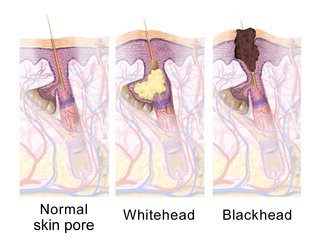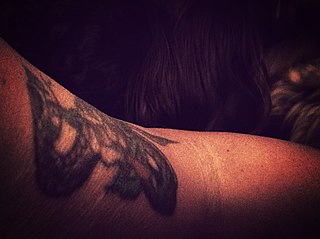
Plastic surgery is a surgical specialty involving the restoration, reconstruction or alteration of the human body. It can be divided into two main categories: reconstructive surgery and cosmetic surgery. Reconstructive surgery includes craniofacial surgery, hand surgery, microsurgery, and the treatment of burns. While reconstructive surgery aims to reconstruct a part of the body or improve its functioning, cosmetic surgery aims at improving the appearance of it. Comprehensive definition of plastic surgery has never been established, because it has no distinct anatomical object and thus overlaps with practically all other surgical specialties. An essential feature of plastic surgery is that it involves treatment of conditions that require or may require tissue relocation skills.
Dermatology is the branch of medicine dealing with the skin. It is a speciality with both medical and surgical aspects. A dermatologist is a specialist medical doctor who manages diseases related to skin, hair, nails, and some cosmetic problems.
Intense pulsed light (IPL) is a technology used by cosmetic and medical practitioners to perform various skin treatments for aesthetic and therapeutic purposes, including hair removal, photorejuvenation as well as to alleviate dermatologic diseases such as acne. IPL is increasingly used in optometry and ophthalmology as well, to treat evaporative dry eye disease due to meibomian gland dysfunction.
Mesotherapy is a form of alternative medicine which involves intradermal or subcutaneous injections of pharmaceutical preparations, enzymes, hormones, plant extracts, vitamins, and/or other ingredients such as hyaluronic acid. It has no proven clinical efficacy and poor scientific backing. Mesotherapy injections allegedly target adipose fat cells, apparently by inducing lipolysis, rupture and cell death among adipocytes. The stated aim of mesotherapy is to provide the skin with essential nutrients, hydration, and other beneficial compounds to rejuvenate and revitalize its appearance.

Hyperpigmentation is the darkening of an area of skin or nails caused by increased melanin.

Hyaluronic acid, also called hyaluronan, is an anionic, nonsulfated glycosaminoglycan distributed widely throughout connective, epithelial, and neural tissues. It is unique among glycosaminoglycans as it is non-sulfated, forms in the plasma membrane instead of the Golgi apparatus, and can be very large: human synovial HA averages about 7 million Da per molecule, or about 20,000 disaccharide monomers, while other sources mention 3–4 million Da.

A comedo is a clogged hair follicle (pore) in the skin. Keratin combines with oil to block the follicle. A comedo can be open (blackhead) or closed by skin (whitehead) and occur with or without acne. The word "comedo" comes from the Latin comedere, meaning "to eat up", and was historically used to describe parasitic worms; in modern medical terminology, it is used to suggest the worm-like appearance of the expressed material.

William Terence Kirby, popularly known as Dr. Will, is an American aesthetic dermatologist, an associate clinical professor of dermatology, and a reality television personality. He is known for winning the CBS reality show Big Brother 2 as well as winning The Price Is Right and appearing on Star Wars television series The Book of Boba Fett.

Tattoo removal is the process of removing an unwanted tattoo. The process of tattooing generally creates permanent markings in the skin, but people have attempted many methods to try to hide or destroy tattoos.
Ava T. Shamban is an American celebrity dermatologist who has made numerous appearances on television and cosmetic publications as an authority on the subject. She is currently a board-certified dermatologist based in Los Angeles, and founder of Ava MD.
Aesthetic medicine is a branch of modern medicine that focuses on altering cosmetic appearance through the treatment of conditions including scars, skin laxity, wrinkles, moles, liver spots, excess fat, cellulite, unwanted hair, skin discoloration, and spider veins. Traditionally, it includes dermatology, oral and maxillofacial surgery, reconstructive surgery and plastic surgery, surgical procedures, non-surgical procedures, and a combination of both. Aesthetic medicine procedures are usually elective. There is a long history of aesthetic medicine procedures, dating back to many notable cases in the 19th century, though techniques have developed much since then.

Mitchel P. Goldman, is an American dermatologic surgeon, cosmetic surgeon, dermatologist, and phlebologist, and the founder and director of Cosmetic Laser Dermatology. He is also a past president of the American Society for Dermatologic Surgery, the American College of Phlebology, the San Diego County Dermatology Society, and the Sonoran Dermatology Society.
Non-surgical rhinoplasty is a medical aesthetic procedure in which injectable fillers, most commonly hyaluronic acid ones like Restylane and Juvederm or calcium hydroxyapatite (Radiesse), are used to alter and shape a person's nose without a surgery. The procedure fills in depressed areas on the nose, lifting the angle of the tip or smoothing the appearance of bumps on the bridge. Non surgical rhinoplasty is an augmentation procedure, so it cannot reduce the size of someone's nose. The cosmetic procedure carries the risk of causing serious skin damage or distant complications like blindness. If the filler product is injected into an artery, filler can travel in the arteries and blocks smaller size arteries like ophthalmic artery and cause blindness. If blood vessels of the skin is blocked, skin necrosis can develop. Hyaluronic acid based fillers can be reversed even if injected into a blood vessel with an enzyme called hyaluronidase, which can be also injected like fillers.
Injectable filler is a soft tissue filler injected into the skin at different depths to help fill in facial wrinkles, provide facial volume, and augment facial features: restoring a smoother appearance. Most of these wrinkle fillers are temporary because they are eventually absorbed by the body. Most dermal fillers today consist of hyaluronic acid, a naturally occurring polysaccharide that is present in skin and cartilage. Some people may need more than one injection to achieve the wrinkle-smoothing effect. The effect lasts for about six months or longer. Successful results depend on health of the skin, skill of the health care provider, and type of filler used. Regardless of material filler duration is highly dependent on amount of activity in the region where it is injected. Exercise and high intensity activities such as manual labor can stimulate blood flow and shorten the lifespan of fillers.
Radio-frequency skin tightening is an aesthetic technique that uses radio frequency (RF) energy to heat skin with the purpose of stimulating cutaneous collagen, elastin and hyaluronic acid production in order to reduce the appearance of fine lines and loose skin. The technique induces tissue remodeling and production of new collagen and elastin. The process provides an alternative to facelift and other cosmetic surgeries.
Nicholas J Lowe is an English dermatologist who has published research into skin pharmacology, botulinum toxins, injectable filler and Lasers in cutaneous and cosmetic Surgery.
Dr. Rashmi Shetty is an Indian board certified dermatologist, teacher, author, and entrepreneur with over 20 years of experience in aesthetic and clinical dermatology. She is known for her transformative yet subtle results with facial enhancement procedures and is a pioneer in bringing injectables and laser technologies to India.

Venkataram Mysore is a dermatologist, dermatopathologist, and hair transplant surgeon from Bangalore, India. He has over 30 years experience as a dermatologist, 18 years as a teacher and is currently the director of the Venkat Center for Advanced Dermatology and Post-Graduate Training.
Laser-assisted drug delivery (LADD) is a drug delivery technique commonly used in the dermatology field that involves lasers. As skin acts as a protective barrier to the environment, the absorption of topical products through the epidermis is limited; thus, different drug delivery modalities have been employed to improve the efficacy of these treatments. The use of lasers in LADD has been shown to enhance the penetration of drugs transdermal, leading to a higher absorption rate, limited systemic effects, and reduced duration of treatment. Although this technique has evolved in the past decade due to its efficacy through scientific research and clinical practice, there remain some limitations regarding the safety aspect that needs to be taken into consideration.
Kavita Mariwalla is a dermatologist and author based in Long Island, New York. She is acknowledged as a leading scholar in skin cancer and aesthetic and medical dermatology and is the president-elect of the American Society for Dermatologic Surgery.







